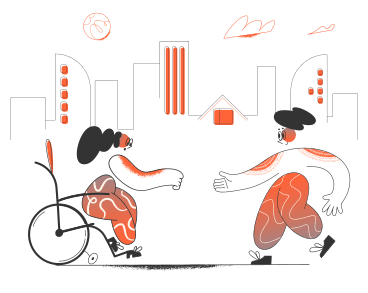menu
designing for all: embracing accessibility in UX as a social and moral responsibility
designing for all: embracing accessibility in UX as a social and moral responsibility
designing for all: embracing accessibility in UX as a social and moral responsibility
designing for all: embracing accessibility in UX as a social and moral responsibility




Continuing on the path of embracing accessibility in UX, I found myself diving deeper into the subject as the New Year approached. What started as a simple goal to cap off 2023 with a certification in accessibility and usability swiftly transformed into a profound journey of social responsibility that reshaped my entire approach to design thinking.
My journey didn't merely involve completing a certification course like "2023 Accessibility & Usability Best Practices for UX & UI Designers (User Experience + WCAG 2.2, Section 508, ADA)." It became a quest to understand accessibility and inclusivity on multiple levels, transcending the confines of a course syllabus.

Along the way, I stumbled upon invaluable resources that shed light on the importance of digital accessibility and its impact on user experiences. One such resource was a thought-provoking Medium article that challenged conventional notions of design and urged designers to prioritize inclusivity in their work.
Read the Medium article here
Additionally, I explored the vast array of resources available on digital accessibility, including a free course on the W3 website (read here). These resources not only provided practical insights into designing for accessibility but also instilled a deeper understanding of the ethical and moral imperatives driving this movement.
Delving further, I delved into Apple's Human - Interface Guidelines, which emphasized the importance of designing interfaces that are intuitive and accessible to all users. Similarly, I explored the intricacies of designing for Android mobiles, immersing myself in Google's material design principles to ensure a seamless experience across different platforms.
As I immersed myself in these resources, I realized that accessibility in UX is not just a checkbox to tick off—it's a fundamental aspect of design that holds the power to transform lives and foster inclusivity. With each new insight gained, my commitment to championing accessibility in UX grew stronger, solidifying my belief that designing for all is not just a social responsibility but a moral imperative that defines the essence of good design.

Inclusive design practices go beyond simply meeting regulatory standards; they involve creating experiences that cater to the diverse needs and abilities of all users. By prioritizing accessibility in UX design, businesses can unlock a multitude of benefits that extend far beyond compliance.
First and foremost, embracing accessibility fosters a more inclusive and welcoming user experience, ensuring that everyone, regardless of their abilities, can engage with a product or service seamlessly. This not only enhances user satisfaction but also broadens the potential user base, tapping into previously underserved demographics and markets.
Moreover, accessible design often leads to better usability for all users, not just those with disabilities. By implementing clear navigation, intuitive interfaces, and concise content, businesses can enhance the overall user experience, resulting in higher engagement, retention, and conversion rates.
Furthermore, accessible design can have significant economic benefits for businesses. Studies have shown that businesses that prioritize accessibility tend to outperform their competitors financially. By making their products and services accessible to a wider audience, businesses can increase market share, drive customer loyalty, and ultimately boost revenue.
date published
Mar 10, 2024
reading time
5 min
Continuing on the path of embracing accessibility in UX, I found myself diving deeper into the subject as the New Year approached. What started as a simple goal to cap off 2023 with a certification in accessibility and usability swiftly transformed into a profound journey of social responsibility that reshaped my entire approach to design thinking.
My journey didn't merely involve completing a certification course like "2023 Accessibility & Usability Best Practices for UX & UI Designers (User Experience + WCAG 2.2, Section 508, ADA)." It became a quest to understand accessibility and inclusivity on multiple levels, transcending the confines of a course syllabus.

Along the way, I stumbled upon invaluable resources that shed light on the importance of digital accessibility and its impact on user experiences. One such resource was a thought-provoking Medium article that challenged conventional notions of design and urged designers to prioritize inclusivity in their work.
Read the Medium article here
Additionally, I explored the vast array of resources available on digital accessibility, including a free course on the W3 website (read here). These resources not only provided practical insights into designing for accessibility but also instilled a deeper understanding of the ethical and moral imperatives driving this movement.
Delving further, I delved into Apple's Human - Interface Guidelines, which emphasized the importance of designing interfaces that are intuitive and accessible to all users. Similarly, I explored the intricacies of designing for Android mobiles, immersing myself in Google's material design principles to ensure a seamless experience across different platforms.
As I immersed myself in these resources, I realized that accessibility in UX is not just a checkbox to tick off—it's a fundamental aspect of design that holds the power to transform lives and foster inclusivity. With each new insight gained, my commitment to championing accessibility in UX grew stronger, solidifying my belief that designing for all is not just a social responsibility but a moral imperative that defines the essence of good design.

Inclusive design practices go beyond simply meeting regulatory standards; they involve creating experiences that cater to the diverse needs and abilities of all users. By prioritizing accessibility in UX design, businesses can unlock a multitude of benefits that extend far beyond compliance.
First and foremost, embracing accessibility fosters a more inclusive and welcoming user experience, ensuring that everyone, regardless of their abilities, can engage with a product or service seamlessly. This not only enhances user satisfaction but also broadens the potential user base, tapping into previously underserved demographics and markets.
Moreover, accessible design often leads to better usability for all users, not just those with disabilities. By implementing clear navigation, intuitive interfaces, and concise content, businesses can enhance the overall user experience, resulting in higher engagement, retention, and conversion rates.
Furthermore, accessible design can have significant economic benefits for businesses. Studies have shown that businesses that prioritize accessibility tend to outperform their competitors financially. By making their products and services accessible to a wider audience, businesses can increase market share, drive customer loyalty, and ultimately boost revenue.
date published
Mar 10, 2024
reading time
5 min
Continuing on the path of embracing accessibility in UX, I found myself diving deeper into the subject as the New Year approached. What started as a simple goal to cap off 2023 with a certification in accessibility and usability swiftly transformed into a profound journey of social responsibility that reshaped my entire approach to design thinking.
My journey didn't merely involve completing a certification course like "2023 Accessibility & Usability Best Practices for UX & UI Designers (User Experience + WCAG 2.2, Section 508, ADA)." It became a quest to understand accessibility and inclusivity on multiple levels, transcending the confines of a course syllabus.

Along the way, I stumbled upon invaluable resources that shed light on the importance of digital accessibility and its impact on user experiences. One such resource was a thought-provoking Medium article that challenged conventional notions of design and urged designers to prioritize inclusivity in their work.
Read the Medium article here
Additionally, I explored the vast array of resources available on digital accessibility, including a free course on the W3 website (read here). These resources not only provided practical insights into designing for accessibility but also instilled a deeper understanding of the ethical and moral imperatives driving this movement.
Delving further, I delved into Apple's Human - Interface Guidelines, which emphasized the importance of designing interfaces that are intuitive and accessible to all users. Similarly, I explored the intricacies of designing for Android mobiles, immersing myself in Google's material design principles to ensure a seamless experience across different platforms.
As I immersed myself in these resources, I realized that accessibility in UX is not just a checkbox to tick off—it's a fundamental aspect of design that holds the power to transform lives and foster inclusivity. With each new insight gained, my commitment to championing accessibility in UX grew stronger, solidifying my belief that designing for all is not just a social responsibility but a moral imperative that defines the essence of good design.

Inclusive design practices go beyond simply meeting regulatory standards; they involve creating experiences that cater to the diverse needs and abilities of all users. By prioritizing accessibility in UX design, businesses can unlock a multitude of benefits that extend far beyond compliance.
First and foremost, embracing accessibility fosters a more inclusive and welcoming user experience, ensuring that everyone, regardless of their abilities, can engage with a product or service seamlessly. This not only enhances user satisfaction but also broadens the potential user base, tapping into previously underserved demographics and markets.
Moreover, accessible design often leads to better usability for all users, not just those with disabilities. By implementing clear navigation, intuitive interfaces, and concise content, businesses can enhance the overall user experience, resulting in higher engagement, retention, and conversion rates.
Furthermore, accessible design can have significant economic benefits for businesses. Studies have shown that businesses that prioritize accessibility tend to outperform their competitors financially. By making their products and services accessible to a wider audience, businesses can increase market share, drive customer loyalty, and ultimately boost revenue.
date published
Mar 10, 2024
reading time
5 min
Continuing on the path of embracing accessibility in UX, I found myself diving deeper into the subject as the New Year approached. What started as a simple goal to cap off 2023 with a certification in accessibility and usability swiftly transformed into a profound journey of social responsibility that reshaped my entire approach to design thinking.
My journey didn't merely involve completing a certification course like "2023 Accessibility & Usability Best Practices for UX & UI Designers (User Experience + WCAG 2.2, Section 508, ADA)." It became a quest to understand accessibility and inclusivity on multiple levels, transcending the confines of a course syllabus.

Along the way, I stumbled upon invaluable resources that shed light on the importance of digital accessibility and its impact on user experiences. One such resource was a thought-provoking Medium article that challenged conventional notions of design and urged designers to prioritize inclusivity in their work.
Read the Medium article here
Additionally, I explored the vast array of resources available on digital accessibility, including a free course on the W3 website (read here). These resources not only provided practical insights into designing for accessibility but also instilled a deeper understanding of the ethical and moral imperatives driving this movement.
Delving further, I delved into Apple's Human - Interface Guidelines, which emphasized the importance of designing interfaces that are intuitive and accessible to all users. Similarly, I explored the intricacies of designing for Android mobiles, immersing myself in Google's material design principles to ensure a seamless experience across different platforms.
As I immersed myself in these resources, I realized that accessibility in UX is not just a checkbox to tick off—it's a fundamental aspect of design that holds the power to transform lives and foster inclusivity. With each new insight gained, my commitment to championing accessibility in UX grew stronger, solidifying my belief that designing for all is not just a social responsibility but a moral imperative that defines the essence of good design.

Inclusive design practices go beyond simply meeting regulatory standards; they involve creating experiences that cater to the diverse needs and abilities of all users. By prioritizing accessibility in UX design, businesses can unlock a multitude of benefits that extend far beyond compliance.
First and foremost, embracing accessibility fosters a more inclusive and welcoming user experience, ensuring that everyone, regardless of their abilities, can engage with a product or service seamlessly. This not only enhances user satisfaction but also broadens the potential user base, tapping into previously underserved demographics and markets.
Moreover, accessible design often leads to better usability for all users, not just those with disabilities. By implementing clear navigation, intuitive interfaces, and concise content, businesses can enhance the overall user experience, resulting in higher engagement, retention, and conversion rates.
Furthermore, accessible design can have significant economic benefits for businesses. Studies have shown that businesses that prioritize accessibility tend to outperform their competitors financially. By making their products and services accessible to a wider audience, businesses can increase market share, drive customer loyalty, and ultimately boost revenue.
date published
Mar 10, 2024
reading time
5 min
.say hello
i'm open for freelance projects, full time roles and happy to collaborate, feel free to email me to see how we can make any of these possible
.say hello
i'm open for freelance projects, full time roles and happy to collaborate, feel free to email me to see how we can make any of these possible
.say hello
i'm open for freelance projects, full time roles and happy to collaborate, feel free to email me to see how we can make any of these possible
.say hello


